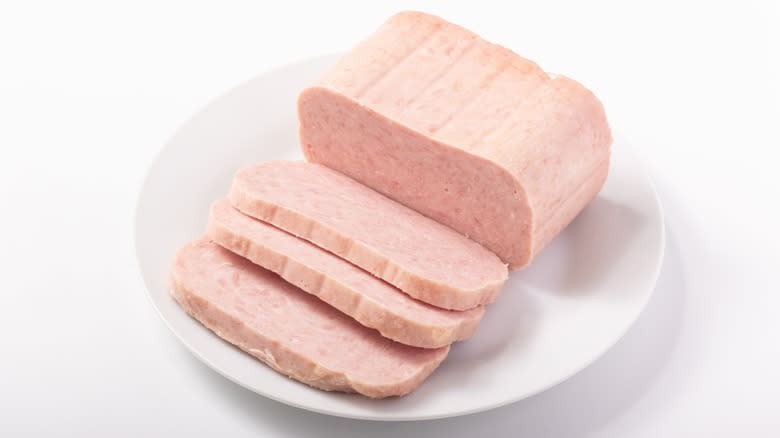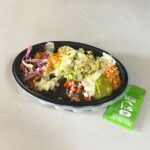Is Spam Healthy Food? This question is frequently asked on FOODS.EDU.VN, and we aim to provide a clear and comprehensive answer. While Spam can be a convenient and affordable source of protein, understanding its nutritional profile and potential health effects is crucial. This article delves into the ingredients, nutritional value, and potential risks associated with regular Spam consumption, offering solutions for those seeking balanced dietary choices. We’ll explore healthier alternatives and ways to enjoy Spam in moderation, focusing on informed food choices and dietary wellness.
1. What Exactly Is Spam? A Culinary and Historical Overview
Spam, a canned cooked pork product, has a fascinating history and a unique place in global cuisine. Understanding its origins and composition helps us better assess whether is Spam healthy food.
1.1 The Origins of Spam: From the Great Depression to World War II
Created in 1937 by Hormel Foods Corporation, Spam was initially intended to provide an affordable and shelf-stable meat option during the Great Depression. Its popularity soared during World War II, as it became a staple food for American soldiers overseas. The shelf stability and ease of transport made it ideal for feeding troops in various locations. Food historian Rachel Laudan highlights the importance of Spam in areas with limited access to fresh food sources, noting its ability to withstand tropical heat and long storage periods.
1.2 Composition of Spam: Ingredients and Processing
Spam primarily consists of pork shoulder and ham, along with salt, water, modified potato starch, sugar, and sodium nitrite to help maintain its color and preserve freshness. The meat is ground, mixed with other ingredients, and then cooked inside the can. This process gives Spam its distinctive texture and long shelf life.
Here’s a breakdown of the typical ingredients found in Spam:
| Ingredient | Purpose |
|---|---|
| Pork Shoulder | Main protein source |
| Ham | Adds flavor and protein |
| Salt | Flavor enhancer, preservative |
| Water | Helps with mixing and processing |
| Modified Potato Starch | Binder, improves texture |
| Sugar | Balances flavor, aids in browning |
| Sodium Nitrite | Preserves color, inhibits bacterial growth |


1.3 Spam’s Global Popularity: A Cultural Phenomenon
Spam’s reach extends far beyond the United States. It’s particularly beloved in regions like Hawaii, Guam, and the Philippines, where it has been integrated into local cuisines. In Hawaii, Spam musubi (Spam on rice, wrapped in nori seaweed) is a ubiquitous snack. Guam residents consume an average of 16 cans of Spam per person annually. This widespread acceptance underscores Spam’s adaptability and its role as a reliable food source in diverse cultures. You can discover more about Spam’s global impact and culinary uses on FOODS.EDU.VN.
2. Nutritional Profile of Spam: A Detailed Analysis
To address the question “is Spam healthy food,” it’s essential to examine its nutritional content thoroughly. Understanding the levels of fat, sodium, protein, and other key nutrients will help you make informed dietary decisions.
2.1 Macronutrient Breakdown: Fat, Protein, and Carbohydrates
A typical 2-ounce (56-gram) serving of Spam contains approximately:
- Calories: 174
- Fat: 15 grams (including 6 grams of saturated fat)
- Protein: 7 grams
- Carbohydrates: 1-2 grams
While Spam provides a decent amount of protein, its high fat content, particularly saturated fat, is a concern. Saturated fats can raise LDL cholesterol levels, increasing the risk of heart disease.
2.2 Micronutrient Content: Vitamins and Minerals
Spam isn’t a significant source of most vitamins and minerals. However, it does contain small amounts of iron and some B vitamins. The processing methods used in preserving Spam reduce the nutritional value. Relying on Spam as a primary source of micronutrients is not advisable; a varied diet is essential for optimal health.
2.3 Sodium Levels: A Major Consideration
One of the most significant drawbacks of Spam is its high sodium content. A single serving contains approximately 790 mg of sodium, which is about 33% of the recommended daily allowance (RDA) for adults. High sodium intake is linked to several health issues, including high blood pressure, heart disease, and kidney problems. The American Heart Association notes that excessive sodium consumption is a widespread problem, with most Americans consuming far more than the recommended amount, largely from processed foods like Spam.
2.4 Comparison with Other Protein Sources
When evaluating is Spam healthy food, it’s helpful to compare it to other protein sources:
| Food | Calories (per 2 oz) | Protein (g) | Fat (g) | Sodium (mg) |
|---|---|---|---|---|
| Spam | 174 | 7 | 15 | 790 |
| Chicken Breast | 94 | 20 | 1 | 33 |
| Salmon | 117 | 17 | 4 | 51 |
| Tofu | 70 | 8 | 4 | 10 |
As the table shows, Spam is significantly higher in calories, fat, and sodium compared to healthier protein options like chicken breast, salmon, and tofu. You can find more detailed nutritional comparisons on FOODS.EDU.VN.
3. Potential Health Risks Associated with Spam Consumption
Excessive consumption of Spam can lead to various health issues, primarily due to its high sodium and fat content. Understanding these risks is essential for making informed dietary choices. So we can truly decide is Spam healthy food for us.
3.1 Impact on Blood Pressure
Spam’s high sodium content can significantly impact blood pressure. Sodium causes the body to retain water, increasing blood volume and, consequently, blood pressure. Studies have shown that reducing salt intake can lower blood pressure, especially in individuals with hypertension. Processed meats like Spam contribute significantly to overall sodium intake, making it crucial to moderate consumption.
3.2 Weight Gain and Obesity
Spam is calorie-dense and high in fat, which can contribute to weight gain if consumed in excess. While fat is an essential part of a balanced diet, consuming more calories than you burn leads to weight gain. Regularly including Spam in your diet without balancing it with exercise and a healthy eating pattern can increase the risk of obesity. The high fat and calorie content of Spam, as compared to other protein sources, makes it a less favorable option for weight management.
3.3 Risk of Bloating and Water Retention
The high sodium content in Spam can lead to bloating and water retention. Sodium causes the body to hold onto water, leading to a bloated feeling. To counteract this, it’s essential to drink plenty of water to help flush out excess sodium. The U.S. National Academies of Sciences, Engineering, and Medicine recommends that men consume about 3.7 liters of fluids a day, and women about 2.7 liters.
3.4 Dehydration and Thirst
Eating salty foods like Spam can trigger thirst due to the way sodium affects the body’s fluid balance. As the blood absorbs excess sodium, it pulls fluid from your cells, leading to dehydration and thirst. Frequent dehydration can lead to other issues, including confusing thirst with hunger, which can contribute to overeating and weight gain.
3.5 Sleep Disturbances
High sodium intake has been linked to diminished sleep quality. Research indicates that consuming too much sodium can make it harder to fall asleep and reduce the likelihood of entering into restorative deep sleep. There is also evidence suggesting a potential link between high sodium consumption and sleep disorders like sleep apnea. If you’re going to consume salty foods like Spam, it’s better to do so earlier in the day to allow your body time to process the sodium.
3.6 Headaches
Increased consumption of sodium has been associated with a higher frequency of headaches. Studies show that individuals who consume less sodium are less likely to suffer headaches. Excess salt consumption may cause blood vessels in the brain to expand, contributing to headaches.
3.7 Kidney Disease
The kidneys process sodium, and overconsumption of sodium-rich foods like Spam can lead to kidney stones or kidney disease, especially over the long term. Reducing salt and protein intake are key recommendations for those with or at risk for kidney disease, as highlighted by the National Kidney Foundation.
3.8 Heart Disease and Diabetes
Processed meats like Spam have been linked to an increased risk of developing both diabetes and coronary heart disease. The nitrates and nitrites in processed meats can convert to nitrosamines when heated, which are risk factors for insulin resistance diseases like type 2 diabetes and cardiovascular disease. Studies have shown a significant increase in the likelihood of developing type 2 diabetes in those who consume more red and processed meats.
3.9 Cancer Risk
The nitrosamines found in processed meats like Spam have also been linked to an increased risk of certain cancers. A review of multiple studies linked nitrosamine consumption to a higher risk of stomach cancer. Other studies have associated the consumption of nitrites and nitrates with a higher risk of brain and thyroid cancer. Balancing Spam consumption with foods rich in cancer-fighting antioxidants, such as berries and leafy greens, is crucial.
4. Is Spam Healthy Food? Context and Moderation
Given the potential health risks, the question “is Spam healthy food” largely depends on context and moderation. Spam can be part of a balanced diet if consumed infrequently and in small portions.
4.1 Occasional Consumption vs. Regular Diet
Enjoying Spam occasionally is unlikely to cause significant health problems for most people. However, incorporating it into your daily diet can lead to adverse health outcomes due to its high sodium and fat content. Moderation is key.
4.2 Serving Size Recommendations
Sticking to a small serving size (2 ounces or 56 grams) can help minimize the negative effects of Spam. Being mindful of portion sizes and balancing Spam with other nutrient-rich foods is essential.
4.3 Balancing with Nutrient-Rich Foods
When you do eat Spam, balance it with plenty of fruits, vegetables, and whole grains. These foods provide essential vitamins, minerals, and fiber that can help offset some of the less desirable aspects of Spam.
4.4 Cooking Methods to Reduce Fat
Consider grilling, baking, or pan-frying Spam without added oil to reduce its fat content. These methods can help render some of the fat, making it a slightly healthier option.
5. Healthier Alternatives to Spam
If you enjoy the taste of Spam but are concerned about its health effects, several healthier alternatives can satisfy your cravings without compromising your well-being. Choosing lean alternatives is a great choice if you are still wondering is Spam healthy food.
5.1 Lean Meats: Chicken, Turkey, and Fish
Lean meats like chicken breast, turkey, and fish are excellent sources of protein with significantly lower fat and sodium content than Spam. These options provide essential nutrients and can be prepared in various ways to suit your taste.
5.2 Plant-Based Protein Sources: Tofu, Tempeh, and Legumes
Plant-based protein sources like tofu, tempeh, and legumes are nutritious alternatives to Spam. They are low in fat and sodium and rich in fiber, vitamins, and minerals. These options can be incorporated into a variety of dishes and offer numerous health benefits.
5.3 Lower-Sodium Processed Meat Options
Some brands offer lower-sodium versions of processed meats that can be a better option than traditional Spam. Always check the nutrition label to compare sodium content and choose the healthiest available option.
5.4 Homemade Spam Alternatives
Creating your own version of Spam at home allows you to control the ingredients and reduce the sodium and fat content. You can use leaner cuts of pork and adjust the seasoning to your liking, creating a healthier and more customized product.
6. Delicious Ways to Enjoy Spam in Moderation
Even with its potential drawbacks, Spam can be enjoyed in moderation as part of a balanced diet. Here are some tasty ways to incorporate it into your meals without overdoing it. You don’t have to completely eliminate it if you are wondering is Spam healthy food, but you can consider moderation.
6.1 Spam Musubi: A Hawaiian Treat
Spam musubi, a popular Hawaiian snack, consists of a slice of grilled Spam on top of a block of rice, wrapped with nori seaweed. To make it healthier, use brown rice and a reduced-sodium Spam variety.
6.2 Spam Fried Rice: A Quick and Easy Meal
Spam fried rice is a versatile dish that can be customized with various vegetables and seasonings. Use a small amount of Spam and load up on colorful veggies like carrots, peas, and bell peppers to create a balanced meal.
6.3 Spam and Egg Breakfast Sandwich
A Spam and egg breakfast sandwich can be a satisfying morning meal when prepared with whole-grain bread and plenty of vegetables. Consider adding spinach, tomatoes, or avocado for extra nutrients.
6.4 Spam Skewers with Vegetables
Thread chunks of Spam onto skewers with your favorite vegetables, such as bell peppers, onions, and zucchini, and grill or bake for a tasty and balanced meal.
7. Expert Opinions and Scientific Research
Expert opinions and scientific research provide valuable insights into the health effects of Spam and processed meats. Consider the following information if you are wondering is Spam healthy food.
7.1 Recommendations from Health Organizations
Health organizations like the American Heart Association and the World Health Organization recommend limiting the consumption of processed meats due to their high sodium and fat content, as well as their association with increased risks of heart disease, diabetes, and certain cancers.
7.2 Findings from Nutritional Studies
Nutritional studies have consistently linked high consumption of processed meats to negative health outcomes. These studies underscore the importance of moderation and choosing healthier protein sources whenever possible.
7.3 Advice from Registered Dietitians
Registered dietitians often advise clients to reduce their intake of processed foods like Spam and focus on whole, unprocessed foods. They can provide personalized recommendations based on individual health needs and dietary preferences.
8. Debunking Common Myths About Spam
Several misconceptions surround Spam and its nutritional value. Addressing these myths can help you make more informed decisions about including it in your diet.
8.1 Myth: Spam Is a Good Source of Vitamins and Minerals
Fact: While Spam contains small amounts of some vitamins and minerals, it is not a significant source of these nutrients. Relying on Spam for your vitamin and mineral intake is not advisable.
8.2 Myth: All Fats in Spam Are Unhealthy
Fact: Spam contains both saturated and unsaturated fats. While saturated fats should be limited, unsaturated fats are beneficial for heart health. However, the overall high fat content of Spam still warrants moderation.
8.3 Myth: Sodium Is Not a Concern for Everyone
Fact: High sodium intake can be detrimental to health, especially for individuals with high blood pressure, kidney problems, or heart disease. Even those without these conditions should be mindful of their sodium intake.
8.4 Myth: Spam Is Only Popular in Certain Regions
Fact: While Spam is particularly popular in places like Hawaii and Guam, it is consumed worldwide and can be found in various cuisines.
9. Practical Tips for Reducing Spam Consumption
If you’re looking to reduce your Spam consumption, here are some practical tips to help you make healthier choices. These considerations may help you decide is Spam healthy food to incorporate into your lifestyle.
9.1 Gradual Reduction Strategies
Start by gradually reducing the amount of Spam you consume each week. Replace it with healthier protein sources like chicken, fish, or legumes.
9.2 Meal Planning and Grocery Shopping Tips
Plan your meals in advance and create a grocery list that focuses on whole, unprocessed foods. Avoid impulse purchases of processed meats like Spam.
9.3 Creative Ways to Use Spam Sparingly
If you enjoy the taste of Spam, use it sparingly in your meals. Add a small amount to fried rice, stir-fries, or salads for flavor without overdoing it.
9.4 Reading Nutrition Labels Carefully
Always read nutrition labels to compare the sodium and fat content of different products. Choose lower-sodium and lower-fat options whenever possible.
10. FOODS.EDU.VN Resources for Healthy Eating
FOODS.EDU.VN offers a wealth of resources to help you make informed dietary choices and maintain a healthy lifestyle.
10.1 Recipe Database with Healthy Alternatives
Explore our recipe database for a wide range of healthy alternatives to Spam and other processed foods. Find delicious and nutritious recipes that suit your dietary preferences and health goals.
10.2 Nutritional Guides and Articles
Access our comprehensive nutritional guides and articles to learn more about the health benefits of different foods and the importance of a balanced diet.
10.3 Expert Advice from Nutritionists and Chefs
Benefit from expert advice from our team of nutritionists and chefs, who provide practical tips and guidance on healthy eating and cooking.
10.4 Community Forum for Sharing Tips and Recipes
Join our community forum to share your own tips and recipes for healthy eating and connect with other like-minded individuals.
A close-up of a can of Spam showcasing the detailed nutritional information, emphasizing the high sodium and fat content.
11. Spam’s Role in Specific Diets
Considering how Spam fits into different dietary patterns is vital in addressing the question: Is Spam healthy food?
11.1 Keto Diet
While Spam is low in carbohydrates, making it technically keto-friendly, its high saturated fat content may not align with the health goals of a ketogenic diet. Healthier fat sources like avocado, nuts, and olive oil are generally preferred.
11.2 Low-Sodium Diet
Spam is not suitable for a low-sodium diet due to its extremely high sodium content. Individuals following a low-sodium diet should avoid Spam and choose alternative protein sources.
11.3 Gluten-Free Diet
Spam is naturally gluten-free, making it an option for individuals with celiac disease or gluten intolerance. However, it is still important to consider its other nutritional drawbacks.
11.4 Paleo Diet
The Paleo diet typically avoids processed foods, making Spam an unsuitable choice. The Paleo diet emphasizes whole, unprocessed foods like lean meats, fruits, and vegetables.
12. Spam Around the World: Culinary Uses
Spam’s culinary versatility is celebrated in various cultures worldwide.
12.1 Hawaii: Spam Musubi and Local Cuisine
In Hawaii, Spam is deeply integrated into local cuisine. Spam musubi is a beloved snack, and Spam is also used in dishes like loco moco, a plate of rice topped with a hamburger patty, fried egg, and gravy.
12.2 Philippines: Spam as a Staple Food
In the Philippines, Spam is a staple food, often eaten with rice and eggs. It is also used in dishes like Spam spaghetti and Spam lumpia (spring rolls).
12.3 Korea: Spam in Budae Jjigae (Army Stew)
In Korea, Spam is a popular ingredient in budae jjigae, a spicy stew that originated during the Korean War. The stew typically includes Spam, sausage, ramen noodles, and vegetables.
12.4 Guam: High Consumption Rates
Guam has one of the highest per capita Spam consumption rates in the world. It is used in a variety of dishes and is a common ingredient in local cuisine.
13. Delicious Spam Recipes
Here are a few recipes incorporating Spam, balancing taste with healthier ingredients and preparation methods. Always consider is Spam healthy food when preparing your meals.
13.1 Healthier Spam Musubi Recipe
Ingredients:
- 1 cup brown rice
- 1 can reduced-sodium Spam
- 2 sheets nori seaweed
- 2 tablespoons soy sauce
- 1 tablespoon honey
Instructions:
- Cook brown rice according to package directions.
- Slice Spam into 1/4-inch thick slices.
- Mix soy sauce and honey in a bowl.
- Marinate Spam slices in the soy sauce mixture for 10 minutes.
- Grill or pan-fry Spam until lightly browned.
- Cut nori sheets into strips.
- Place a slice of Spam on top of a block of rice and wrap with a strip of nori.
13.2 Spam and Vegetable Fried Rice
Ingredients:
- 1 cup cooked brown rice
- 1/4 can reduced-sodium Spam, diced
- 1 cup mixed vegetables (carrots, peas, corn)
- 1 egg, scrambled
- 1 tablespoon soy sauce
- 1 teaspoon sesame oil
Instructions:
- Heat sesame oil in a pan or wok.
- Add diced Spam and cook until lightly browned.
- Add mixed vegetables and cook until tender.
- Push vegetables and Spam to one side of the pan.
- Pour in scrambled egg and cook until set.
- Add cooked rice and soy sauce to the pan.
- Stir everything together until well combined.
13.3 Grilled Spam and Vegetable Skewers
Ingredients:
- 1/2 can reduced-sodium Spam, cubed
- 1 cup mixed vegetables (bell peppers, onions, zucchini)
- 2 tablespoons olive oil
- 1 tablespoon lemon juice
- Salt and pepper to taste
Instructions:
- Thread Spam and vegetables onto skewers.
- Mix olive oil, lemon juice, salt, and pepper in a bowl.
- Brush skewers with the olive oil mixture.
- Grill or bake skewers until vegetables are tender and Spam is lightly browned.
14. The Future of Processed Meats: Trends and Innovations
The processed meat industry is evolving, with a focus on healthier alternatives and sustainable practices.
14.1 Reduced-Sodium and Reduced-Fat Options
Many companies are now offering reduced-sodium and reduced-fat versions of processed meats, catering to health-conscious consumers.
14.2 Plant-Based Alternatives
Plant-based alternatives to processed meats are gaining popularity, providing a sustainable and nutritious option for those looking to reduce their meat consumption.
14.3 Sustainable Packaging
Companies are increasingly adopting sustainable packaging practices to reduce their environmental impact.
14.4 Innovations in Meat Processing
New technologies in meat processing are being developed to improve the nutritional profile and safety of processed meats.
15. FAQs About Spam
Here are some frequently asked questions about Spam and its health effects:
- Is Spam a good source of protein?
- Spam provides a moderate amount of protein (7 grams per serving), but other protein sources are healthier options.
- Can I eat Spam every day?
- Eating Spam every day is not recommended due to its high sodium and fat content.
- Is Spam gluten-free?
- Yes, Spam is naturally gluten-free.
- What are the main health concerns associated with Spam?
- The main health concerns are high blood pressure, weight gain, heart disease, kidney problems, and increased risk of certain cancers.
- How can I make Spam healthier?
- Choose reduced-sodium varieties, use smaller portions, and balance with plenty of vegetables and whole grains.
- What are some healthier alternatives to Spam?
- Chicken breast, turkey, fish, tofu, tempeh, and legumes are healthier alternatives.
- Is Spam suitable for a low-sodium diet?
- No, Spam is not suitable for a low-sodium diet.
- Can Spam cause bloating?
- Yes, the high sodium content in Spam can cause bloating and water retention.
- Does Spam contain nitrates?
- Yes, Spam contains sodium nitrite, which can convert to nitrosamines when heated.
- Where can I find healthier recipes using Spam?
- Visit FOODS.EDU.VN for a variety of healthier recipes using Spam and other ingredients.
An array of diverse and healthy protein sources, including fresh fish, lean poultry, tofu, and legumes, offers alternatives to processed meats.
Conclusion: Making Informed Choices
So, is Spam healthy food? While Spam can be a convenient and tasty addition to your diet in moderation, it’s essential to be aware of its potential health risks. By understanding its nutritional profile and balancing it with healthier foods, you can enjoy Spam without compromising your well-being.
For more information on healthy eating and delicious recipes, visit FOODS.EDU.VN. Our resources can help you make informed dietary choices and maintain a balanced lifestyle.
Ready to explore more nutritious options and culinary insights? Visit FOODS.EDU.VN today to discover a world of healthy eating! For personalized guidance and support, contact us at 1946 Campus Dr, Hyde Park, NY 12538, United States, or reach out via WhatsApp at +1 845-452-9600. Let foods.edu.vn be your partner in achieving a healthier, happier you!

